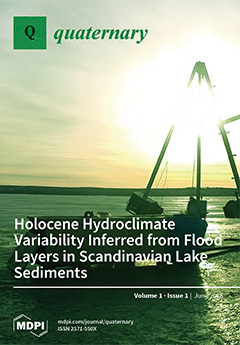Quaternary, Volume 1, Issue 1 (June 2018) – 8 articles
Since the onset of the neoglacial period (≈4000 cal yr BP), a tree line descent and the increased occurrence of strong snowmelt flood events caused stronger soil erosion. These vegetation/climate shifts are indicated by the more frequent occurrence of black (flood) layers in the sediments. Their peak ≈2600 cal yr BP coincides with a prominent solar minimum and the prevalence of a negative NAO index. View this paper.
- Issues are regarded as officially published after their release is announced to the table of contents alert mailing list.
- You may sign up for e-mail alerts to receive table of contents of newly released issues.
- PDF is the official format for papers published in both, html and pdf forms. To view the papers in pdf format, click on the "PDF Full-text" link, and use the free Adobe Reader to open them.





